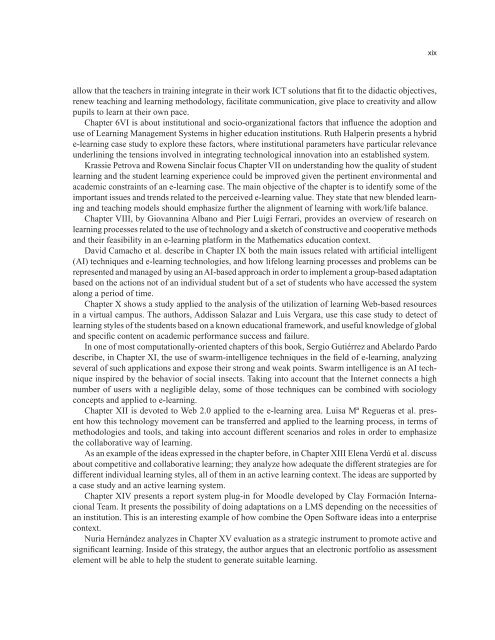Advances in E-learning-Experiences and Methodologies
You also want an ePaper? Increase the reach of your titles
YUMPU automatically turns print PDFs into web optimized ePapers that Google loves.
allow that the teachers <strong>in</strong> tra<strong>in</strong><strong>in</strong>g <strong>in</strong>tegrate <strong>in</strong> their work ICT solutions that fit to the didactic objectives,<br />
renew teach<strong>in</strong>g <strong>and</strong> learn<strong>in</strong>g methodology, facilitate communication, give place to creativity <strong>and</strong> allow<br />
pupils to learn at their own pace.<br />
Chapter 6VI is about <strong>in</strong>stitutional <strong>and</strong> socio-organizational factors that <strong>in</strong>fluence the adoption <strong>and</strong><br />
use of Learn<strong>in</strong>g Management Systems <strong>in</strong> higher education <strong>in</strong>stitutions. Ruth Halper<strong>in</strong> presents a hybrid<br />
e-learn<strong>in</strong>g case study to explore these factors, where <strong>in</strong>stitutional parameters have particular relevance<br />
underl<strong>in</strong><strong>in</strong>g the tensions <strong>in</strong>volved <strong>in</strong> <strong>in</strong>tegrat<strong>in</strong>g technological <strong>in</strong>novation <strong>in</strong>to an established system.<br />
Krassie Petrova <strong>and</strong> Rowena S<strong>in</strong>clair focus Chapter VII on underst<strong>and</strong><strong>in</strong>g how the quality of student<br />
learn<strong>in</strong>g <strong>and</strong> the student learn<strong>in</strong>g experience could be improved given the pert<strong>in</strong>ent environmental <strong>and</strong><br />
academic constra<strong>in</strong>ts of an e-learn<strong>in</strong>g case. The ma<strong>in</strong> objective of the chapter is to identify some of the<br />
important issues <strong>and</strong> trends related to the perceived e-learn<strong>in</strong>g value. They state that new blended learn<strong>in</strong>g<br />
<strong>and</strong> teach<strong>in</strong>g models should emphasize further the alignment of learn<strong>in</strong>g with work/life balance.<br />
Chapter VIII, by Giovann<strong>in</strong>a Albano <strong>and</strong> Pier Luigi Ferrari, provides an overview of research on<br />
learn<strong>in</strong>g processes related to the use of technology <strong>and</strong> a sketch of constructive <strong>and</strong> cooperative methods<br />
<strong>and</strong> their feasibility <strong>in</strong> an e-learn<strong>in</strong>g platform <strong>in</strong> the Mathematics education context.<br />
David Camacho et al. describe <strong>in</strong> Chapter IX both the ma<strong>in</strong> issues related with artificial <strong>in</strong>telligent<br />
(AI) techniques <strong>and</strong> e-learn<strong>in</strong>g technologies, <strong>and</strong> how lifelong learn<strong>in</strong>g processes <strong>and</strong> problems can be<br />
represented <strong>and</strong> managed by us<strong>in</strong>g an AI-based approach <strong>in</strong> order to implement a group-based adaptation<br />
based on the actions not of an <strong>in</strong>dividual student but of a set of students who have accessed the system<br />
along a period of time.<br />
Chapter X shows a study applied to the analysis of the utilization of learn<strong>in</strong>g Web-based resources<br />
<strong>in</strong> a virtual campus. The authors, Addisson Salazar <strong>and</strong> Luis Vergara, use this case study to detect of<br />
learn<strong>in</strong>g styles of the students based on a known educational framework, <strong>and</strong> useful knowledge of global<br />
<strong>and</strong> specific content on academic performance success <strong>and</strong> failure.<br />
In one of most computationally-oriented chapters of this book, Sergio Gutiérrez <strong>and</strong> Abelardo Pardo<br />
describe, <strong>in</strong> Chapter XI, the use of swarm-<strong>in</strong>telligence techniques <strong>in</strong> the field of e-learn<strong>in</strong>g, analyz<strong>in</strong>g<br />
several of such applications <strong>and</strong> expose their strong <strong>and</strong> weak po<strong>in</strong>ts. Swarm <strong>in</strong>telligence is an AI technique<br />
<strong>in</strong>spired by the behavior of social <strong>in</strong>sects. Tak<strong>in</strong>g <strong>in</strong>to account that the Internet connects a high<br />
number of users with a negligible delay, some of those techniques can be comb<strong>in</strong>ed with sociology<br />
concepts <strong>and</strong> applied to e-learn<strong>in</strong>g.<br />
Chapter XII is devoted to Web 2.0 applied to the e-learn<strong>in</strong>g area. Luisa Mª Regueras et al. present<br />
how this technology movement can be transferred <strong>and</strong> applied to the learn<strong>in</strong>g process, <strong>in</strong> terms of<br />
methodologies <strong>and</strong> tools, <strong>and</strong> tak<strong>in</strong>g <strong>in</strong>to account different scenarios <strong>and</strong> roles <strong>in</strong> order to emphasize<br />
the collaborative way of learn<strong>in</strong>g.<br />
As an example of the ideas expressed <strong>in</strong> the chapter before, <strong>in</strong> Chapter XIII Elena Verdú et al. discuss<br />
about competitive <strong>and</strong> collaborative learn<strong>in</strong>g; they analyze how adequate the different strategies are for<br />
different <strong>in</strong>dividual learn<strong>in</strong>g styles, all of them <strong>in</strong> an active learn<strong>in</strong>g context. The ideas are supported by<br />
a case study <strong>and</strong> an active learn<strong>in</strong>g system.<br />
Chapter XIV presents a report system plug-<strong>in</strong> for Moodle developed by Clay Formación Internacional<br />
Team. It presents the possibility of do<strong>in</strong>g adaptations on a LMS depend<strong>in</strong>g on the necessities of<br />
an <strong>in</strong>stitution. This is an <strong>in</strong>terest<strong>in</strong>g example of how comb<strong>in</strong>e the Open Software ideas <strong>in</strong>to a enterprise<br />
context.<br />
Nuria Hernández analyzes <strong>in</strong> Chapter XV evaluation as a strategic <strong>in</strong>strument to promote active <strong>and</strong><br />
significant learn<strong>in</strong>g. Inside of this strategy, the author argues that an electronic portfolio as assessment<br />
element will be able to help the student to generate suitable learn<strong>in</strong>g.<br />
xix


